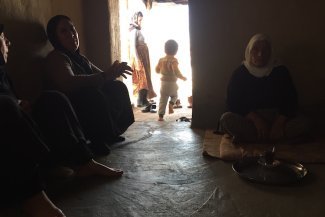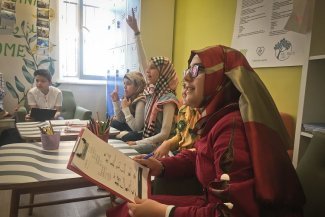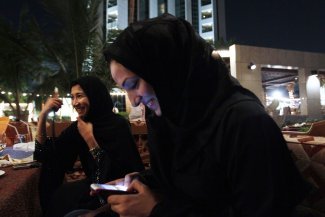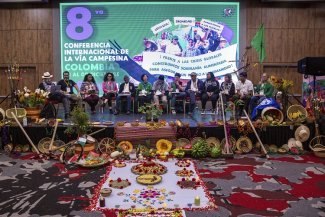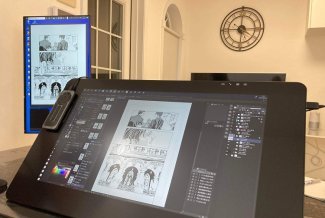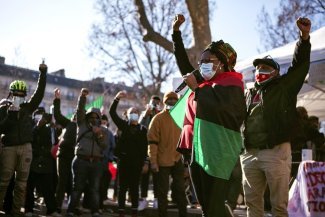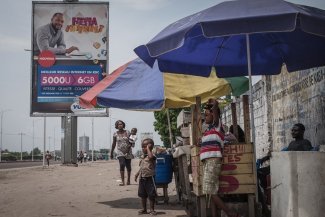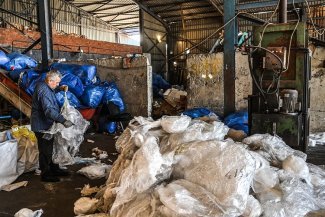
Hind Al-Ahamad, a shawish or governor of three refugee camps, overseeing the distribution of water.
Hind Al-Ahamad is a woman brimming with energy and initiative. She has called on the children in the camp to sweep and collect the rubbish at the entrance to the tents and, whilst overseeing this task, she is sorting and counting the bags of bread that she is about to distribute to each refugee family, at the same time as talking on the phone with the water company, because the water tanker has not yet arrived.
Al-Ahamad is one of Lebanon’s first women shawish, the title given to those who run refugee camps there. It is a role traditionally held by men. But the deep economic crisis in the host country is changing the dynamic in the camps and more refugee women are taking on positions of responsibility and leadership roles in their communities.
It has not been easy for Al-Ahamad to get to where she is today. Until 2018, the idea of a female leader was unheard of in the camps in the Bekaa Valley in eastern Lebanon, where most of the refugees are concentrated, so she was under a great deal of pressure. First, she had to win the support and approval of her husband, who is working in Africa (for want of opportunities in Lebanon); then, she had to win the respect of the refugee community, which has a tribal structure – centred on the family and submission to the leader, who is always a man. “Since my husband is away, my eldest son is the one in charge of giving approval,” explains Al-Ahamad.
“When they [my family] saw that the community was happy with me, that they respected me, and that I liked doing my job, they supported me,” she says.
“I’m appreciated because I am honest and because I like to listen to the community,” says Al-Ahamad, referring to the fact that the shawish is usually an authoritarian figure who is feared by the community, a person with decision-making power, who allows or denies refugees entry to a camp, hires day labourers and pays them, and often treats women unequally.
Al-Ahamad, by contrast, makes sure that the women working in the camp receive their pay. She monitors the distribution of food and clothing to ensure that humanitarian aid reaches all the families equally and makes sure the camp is kept clean. Her role as a leader began in her own camp, which she renamed Jasmine, after filling it with these flowers to remind her of the smell of her garden in Damascus. A few years ago, she was also chosen to lead two neighbouring camps.
Barriers for refugee men...doors opened for refugee women
It must first be understood that Syria is a patriarchal society where the role of women, especially in rural areas, is often confined to the home. “It is not socially acceptable for women to work, as it means that the man is not able to fulfil his duty as head of the household,” explains Lynn Kseibi, a Syrian gender and development expert.
In Lebanon, a range of economic and social factors have contributed to a change of mindset within refugee communities, as this is a less conservative country, with people of 18 different faiths living alongside each other. Then there is the nuclear family that has been broken up by the forced displacements driven by the war in Syria, which can generate a greater sense of freedom among women no longer weighed down by the whole family, according to Kseibi.
In many cases, the women are widowed or have come to Lebanon without their husbands – who are often missing. “The circumstances lead them to become the heads of their households and to take on work outside the home,” adds the expert. The mobility restrictions on Syrian refugees has also played a decisive role.
In 2015, the Lebanese government ended its open-door policy for Syrians, introducing entry requirements and restrictive guidelines for the granting of residence permits. The measures were designed to deter Syrian refugees from staying in Lebanon. The new residency regulations divided refugees into two categories: those registered with the UN Refugee Agency, UNHCR, and those not. To be able to stay in the country legally, those not registered with UNHCR were required to have a Lebanese sponsor. Both categories were also required to pay US$200 (€178) in annual fees to renew their residency. The inability to pay the residence permit fee has forced 80 per cent of Syrians to cease being legally registered. In other words, only 20 per cent of Syrian refugees over the age of 15 had legal residency in 2020. And 89 per cent are now having to live on less than the equivalent of US$25 (€22) a month, according to UNHCR.
Male refugees in Lebanon are seen as ‘a threat’ to Lebanese society, whilst women are seen as ‘vulnerable’. This has led to more women seeking remunerated activities to generate income outside the home, as “it would be frowned upon for the police or the army to arrest a refugee woman who is in the country illegally,” explains Kseibi.
The outcome of this set of circumstances is that Syrian refugee women in Lebanon now have a role in both public and private life that they did not previously have in Syria.
“This collective empowerment will have huge consequences for Syrian society in the coming years, both in terms of impact on the local economy and in terms of changes in social norms and gender roles,” predicts Kseibi.
According to a report published on ReliefWeb, the majority of refugee women surveyed (83 per cent) feel that they now have a larger role within their households and in society, and that there is some acceptance of women’s leadership and involvement in public life.
Al-Ahamad does not do all the work on her own. She is assisted by the women in the camps who have set up committees to help run their communities. This would not have been possible without the contribution of the NGOs working in the camps to empower refugee women. But, as Omar Abdala, general coordinator of SAWA, a local NGO, explains: “They are the ones who present their projects. They want to learn and they have a lot of initiative. We just support them.”
SAWA helps to finance small businesses run by women in the camps, through microcredits. One example is a bakery that was employing refugee women to make bread for their community, and enabling them to be less dependent on humanitarian aid.
Unfortunately, due to the severe economic crisis and high inflation in Lebanon, the NGO no longer has the funds to be able to continue buying flour, which has risen by nearly 18 per cent since 2019, or to give them a payment equivalent to the current value of the Lebanese pound, which has lost more than 80 per cent of its value. “At the end of last year, we had to shut down the oven that was providing sustenance for over 4,000 families,” he laments.
Empowering girls, “they are the future of Syria”
Omar Abdala stresses that a great deal of progress has been made since 2018 with empowering refugee women, but warns that without an end to “this deep crisis, we risk going back to square one”.
Women represent 52.5 per cent of the total Syrian refugee population but, according to the International Labour Organization (ILO), only seven per cent were part of the refugee labour force before 2017. During the 2020 to 2021 period, however, between 17 and 19 per cent of Syrian women became heads of households.
Refugee women, as Abdala observes, have discovered “through their work, what they are capable of, that they can raise their children and help them get ahead. The experience of confronting extreme vulnerability and still getting ahead is a source of empowerment and resilience in itself.”
More refugee women are now thinking about the negative impacts of child marriage, and how it affects children’s education and independence.
“When girls do not go to school, they are exposed to early marriage, which compromises their development. I also believe that early marriage puts girls at risk of domestic violence. I didn’t use to see it this way, but now I have a different perspective,” says Maha Al Doud, a shawish in another camp, in Bar Elias (Bekaa Valley). Like most of her peers, Maha grew up in a patriarchal environment but circumstances led her to become the head of her household following her husband’s disappearance in 2011.
“I belong to a generation of women that have not been able to study. In Lebanon, refugee girls have the opportunity to go to school, but when the pandemic started, the schools were closed,” she says. Maha worries that with the economic crisis in Lebanon, more children will drop out of school permanently and the same patriarchal patterns will repeat themselves. During the 2020-2021 school year, of the almost 522,000 registered Syrian refugees of school age, 30 per cent of those aged 6 to 17 had never attended school, and only 11 per cent of those aged 15 to 24 were enrolled in education.
In an attempt to break the vicious cycle of poverty and markedly patriarchal social patterns, Maha encourages the women in the camp to learn to read and write by attending sessions with a volunteer teacher that she herself found. “Literacy is a powerful tool for women. We are the ones who have to empower our daughters, because they are the future of Syria,” she insists.



